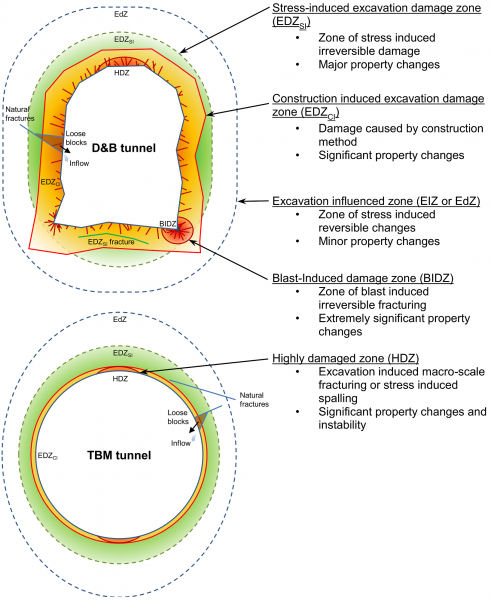Excavation damage zones
In the excavation damage zone context, the blast-induced and stress-induced excavation damage are often clumped without clear terminological definition. Posiva and SKB collaboratively conducted a project between 2010 and 2012 implementing an in situ stress measurement campaign (Hakala et al., 2014), and in 2013 (Siren et al., 2015) ground penetrating radar (GPR) investigations in the Äspö TBM tunnel. Also recent data from Posivas underground rock characterization facility were adopted. The investigations revealed information about the stress-induced and construction-induced damage zones.
For the tunnel stability and reinforcement analysis, the stress-induced EDZSI and construction-induced EDZCI constitute the most significant damage zones, since they remarkably and irreversibly change the rock properties in a significant depth. The stress-induced EDZSI contains inevitable excavation consequences (Harrison and Hudson 1997):
- Displacements due to unloading, where the excavated rock mass is unable to provide support pressure to the remaining rock mass. This leads to block falls and deformations (almost always meaning shrinking of the excavation area).
- Redistribution of stresses, leading to a number of locations with significant stress peaks and lows.
- Water inflow due to fluid pressure being lowered to atmospheric pressure near opening, causing water flow towards the excavation.
The rock and fracture properties change more significantly near the excavation (Davies and Bernier, 2003; Lanyon, 2011). The construction-induced excavation damage EDZCI extends in a drill-and-blast tunnel from 0.1 m to as much as 1.5 m into the rock, increasing permeability by two or three orders of magnitude (Tsang et al., 2005). However, in the TBM tunnel, the EDZCI extends from 1 to 3 cm with increasing permeability by one order of magnitude (Emsley et al., 1997; Davies and Bernier, 2003). Because of its significance, the damage caused by explosions are often simplified to be the only source of excavation damage in the D&B method context.
The excavation-influenced zone (EIZ) is typically used to distinguish the outer zone around the opening, where reversible changes caused by stress redistribution have occurred (Lanyon, 2011; Hudson et al., 2008; Davies and Bernier, 2003). Often the acronym EdZ (Excavation disturbed zone) is used; however, it can easily be confused with the acronym EDZ. Also the reversibility of the change conflicts with the term disturbed and it can be considered to have wrong implications. Therefore EIZ is suggested to be used, instead. The extent of EIZ is hard to define as stress redistributions can stretch far from the opening.

A compilation of damage zones with their definitions is illustrated in a generic stress field. (Siren, 2015)
The EDZCI and EDZSI are of opposite nature. Based on experience, the EDZCI decreases and EDZSI increases with depth (vertical distance from ground surface). This is because the deep tunnels experience higher stresses, thus more energy is required for propagating new fractures in blasting and thereby the depth extent of the EDZCI damage is decreased. Also the rock mass quality improves with depth and, for example in the nuclear waste disposal site in Finland, the first 100 metres are more fractured due to erosion and similar processes (Posiva, 2012). Contrastively, the EDZSI increases with depth due to increasing stresses and increasing rock quality. In deep mines, the depth of EDZSI can exceed the depth of EDZCI. In the LVDT cell stress measurement technique from tunnel surface, the measurements are conducted beyond the most severe EDZ.
With the EDZSI, EDZCI and EIZ being the main damage zones, literature distinquishes sections within these zones that are of particular interest. The highly damaged zone (HDZ) is the part of the excavation that has suffered considerably from stress-induced damage such as spalling or construction-induced damage such as crushed rock near blast holes. The macro-scale fracturing is also sometimes referred to as the blast-induced damage zone (BIDZ or BID in literature). If the two excavation damage zones (EDZCI and EDZSI) cannot be distinguished, it is recommended to use the term EDZ to combine zone properties.
References
Hakala, M., Siren, T., Kemppainen, K., Christiansson,R., and Martin,C.D. (2014). In Situ Stress Measurement with LVDT-Cell – Method Description and Verification. Posiva Report 2012-43. Eurajoki: Posiva Oy.
Harrison, John A. and Hudson, J. (1997). Engineering Rock Mechanics Part II: Illustrative Worked Examples. Burlington: Pergamon.
Davies, C. and Bernier, F. (2003). Impact of the Excavation Disturbed Or Damaged Zone (EDZ) on the Performance of Radioactive Waste Geological Repositories. Proceedings of the European Commission Cluster Conference and Workshop held in Luxembourg.
Emsley, S.O., Olsson,O., Stenberg,L., Alheid,H.J., and Falls,S. (1997). Zedex – A Study of Damage and Disturbance from Tunnel Excavation by Blasting and Tunnel Boring. Technical Report 97-30. Stockholm, Sweden: Swedish Nuclear Fuel Waste Management Company.
Hudson, J., Bäckström, A., Rutqvist, J., Jing, L., Backer, T., Chijimatsu, M., Feng, X., Kobayashi, A., Koyama, T., and Lee, H. (2008). Final Report of DECOVALEX THMC Task B (EDZ Guidance Document) Characterising and Modelling the Excavation Damaged Zone (EDZ) in Crystalline Rock in the Context of Radioactive Waste Disposal. SKI Report 43.
Lanyon, G. (2011). OPG’s Deep Geologic Repository for Low and Intermediate Level Waste – Excavation Damaged Zones Assessment. Report DGR-TR-2011-21. Toronto: Nuclear Waste Management Organization (NWMO). Toronto, Canada.
Posiva. (2012). Olkiluoto Site Description 2011. Posiva Report 2011-02. Eurajoki: Posiva.
Siren, T. (2015). Excavation damage zones, fracture mechanics simulation and in situ strength of migmatitic gneiss and pegmatitic granite at the nuclear waste disposal site in Olkiluoto, Western Finland. Dissertation thesis. Aalto University. ISBN 978-952-60-6517-5.
Siren, T., Kantia, P., and Rinne, M. (2015). Considerations and Observations of Stress-Induced and Construction-Induced Excavation Damage Zone in Crystalline Rock. International Journal of Rock Mechanics and Mining Sciences 73, pp. 165-174. DOI: 10.1016/j.ijrmms.2014.11.001
Tsang, C., Bernier,F., and Davies,C. (2005). Geohydromechanical Processes in the Excavation Damaged Zone in Crystalline Rock, Rock Salt, and Indurated and Plastic Clays—in the Context of Radioactive Waste Disposal. International Journal of Rock Mechanics and Mining Sciences 42 (1), pp. 109-125.

